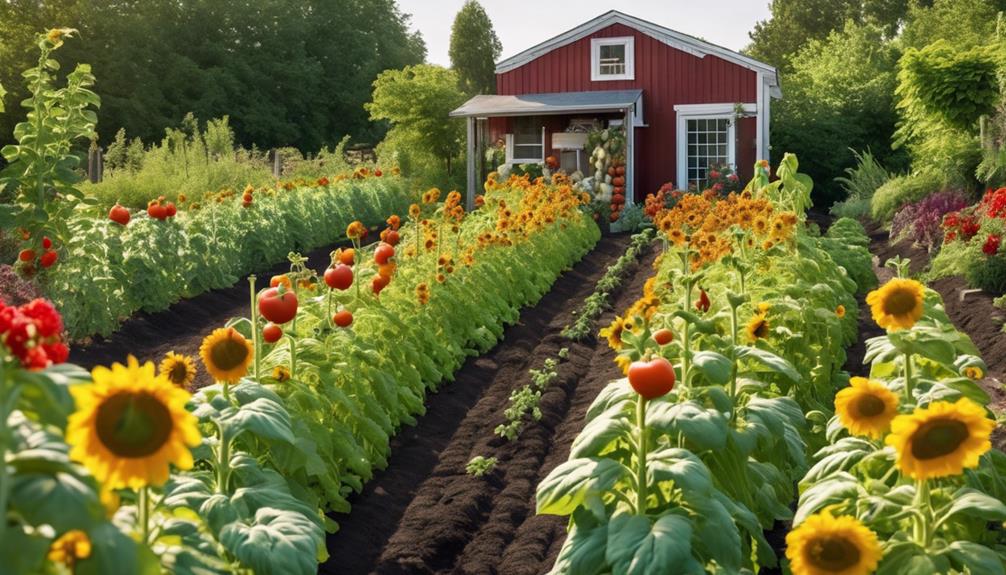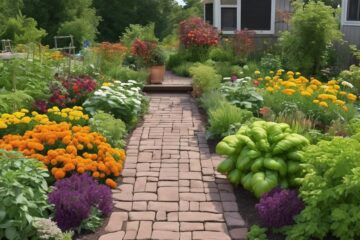Imagine transforming your vegetable garden from struggling to thriving simply by strategically pairing your plants. Picture the vibrant colors, increased yields, and natural pest control that companion planting can bring to your garden.
As you explore the nuances of this ancient practice, you’ll uncover the secrets to harmonious plant relationships that can revolutionize your gardening experience. Discover how understanding the intricate dance between plants can unlock a world of possibilities for your garden’s success.
Understanding Companion Planting Basics
To understand the basics of companion planting, consider the symbiotic relationships between different plants in your garden. Companion planting involves planting compatible plants together to promote plant growth and protect against pests.
Before starting your garden, it’s crucial to plan plant combinations carefully. Proper garden preparation, such as soil enrichment and spacing, plays a vital role in the success of companion planting. Additionally, incorporating crop rotation techniques can help maintain soil health and prevent the buildup of pests and diseases.
Effective pest management is another key aspect to consider, as certain plant combinations can naturally repel harmful insects. Understanding these fundamentals of companion planting is essential for maximizing the productivity and health of your garden.
Selecting Compatible Plant Partners
To effectively select compatible plant partners for companion planting, assess their individual needs and interactions within the garden ecosystem. Take into account the specific plant needs, such as sunlight, water, and soil preferences, to make sure they complement each other.
Look for plants that have mutually beneficial interactions, like repelling pests or enhancing growth. Choose compatible partners that offer natural pest protection to one another, creating a symbiotic relationship. Certain plant combinations naturally thrive together, promoting a healthier garden environment overall.
By carefully selecting plant partners that work well together, you can maximize pest control and growth benefits. Create a harmonious garden by strategically pairing plants that support each other’s well-being. Remember to take into account the mutual benefits that certain plants can bring to their companions, enhancing the overall success of your garden ecosystem.
Make informed choices to optimize pest protection and plant health through companion planting.
Consider the specific needs and interactions of plants to effectively select compatible plant partners for your garden. When choosing companion plants, keep in mind that planting is best when plants benefit each other. Look for combinations that repel pests, help with nutrient uptake, or enhance overall plant health. Some plants naturally grow together and create a mutual benefit, such as enhancing flavor, yield, and resilience in the garden. By selecting compatible plant partners thoughtfully, you can create a harmonious and productive garden ecosystem.
Companion plants aid in pest control and nutrient uptake.
Proper pairings create a harmonious garden ecosystem.
Some plants naturally repel pests and enhance flavor.
Mutual benefits like improved resilience and yield can be observed in certain plant partnerships.
Implementing Crop Rotation Strategies
Consider implementing crop rotation strategies to optimize soil health and plant productivity in your garden. Crop rotation is a key practice that can help address issues like nutrient depletion, pest buildup, soil nutrition, and disease prevention.
Here are some essential points to guide you in successfully implementing crop rotation techniques:
- Preventing Nutrient Depletion: Rotating crops helps maintain a healthy balance of nutrients in the soil, ensuring that plants have access to the necessary elements for robust growth.
- Managing Pest Buildup: By changing the location of vegetable families each season, you can disrupt pest life cycles and reduce the buildup of harmful insects in your garden.
- Balancing Soil Nutrition: Crop rotation techniques contribute to balanced soil nutrition, providing plants with a fertile environment to thrive and produce higher yields.
- Enhancing Disease Prevention: Rotating crops is an effective way to prevent the spread of diseases and pests, promoting overall garden health and productivity.
Maximizing Garden Space Efficiency:
Now that you’ve mastered companion planting, get ready to reap the rewards of your garden oasis.
Did you know that companion planting can increase crop yields by up to 40%?
By strategically pairing plants and implementing natural pest control methods, you’ll be well on your way to a thriving and sustainable garden.
Say goodbye to synthetic chemicals and hello to a more harmonious and eco-friendly approach to gardening.
Companion Planting
Utilize vertical space in your garden by planting vining crops like beans or cucumbers on trellises or fences to maximize ground space. Interplant quick-growing crops like radishes between slower-growing plants to make efficient use of space and ensure continuous harvests. Consider succession planting to fill gaps in the garden and extend the growing season, planting new crops as others are harvested. Utilize raised beds or square foot gardening techniques to efficiently organize plants and make the most of limited space.
- Planting Corn and Beans Together: Corn provides support for beans, allowing them to climb while beans fix nitrogen into the soil for corn.
- Making Good Companion Plants: Marigolds repel aphids, making them excellent companions for many vegetable plants.
- Plants to Grow Together for Mutual Benefit: Planting basil near tomatoes improves the flavor of the tomatoes and repels pests that harm them.
- Easy-to-Read Planting Guides: Refer to companion planting charts for quick and effective guidance on which plants work well together.
Monitoring and Adjusting Plant Combinations
Regularly monitoring and adjusting plant combinations is key to optimizing growth and yield in your garden. By actively monitoring plant health, you can help prevent issues like pests or diseases that may arise from incompatible pairings.
Adjust plant arrangements based on observed interactions between different species to ensure a harmonious environment. Experimenting with combinations allows you to find the most beneficial arrangements for your specific garden.
Record your observations in a gardening journal to track the success of various companion planting strategies over time. This proactive approach will enable you to fine-tune your plant combinations and create a thriving ecosystem where plants support each other’s growth.
Regularly assess plant health indicators like color, growth, and pest presence to effectively determine necessary adjustments in your plant combinations. Observing how plants interact with each other, such as shading effects or pest attraction, can help you fine-tune your pairings.
Keeping a gardening journal to log your observations, experiments, and successful plant combinations will provide valuable insights for future reference. Don’t be afraid to experiment with different plant combinations to optimize growth, enhance pest resistance, and improve overall garden health.
Remember to adjust your plant arrangements based on your documented outcomes to create a thriving and balanced garden ecosystem.
- Assess plant health indicators: Color, growth, and pest presence.
- Observe plant interactions: Shading effects, resource competition, and pest attraction.
- Keep a gardening journal: Record observations, experiments, and successful plant pairings.
- Experiment with different combinations: Optimize growth, pest resistance, and garden health.
Frequently Asked Questions
What Are the Basics of Companion Planting?
To start companion planting, understand plant relationships. Pair plants that benefit each other, like basil and tomatoes. Avoid combining incompatible plants. Consider sun, soil, and water needs. Planning is key for successful harvests.
Is There an App for Companion Planting?
Yes, there’s an app for companion planting. You can find mobile apps like ‘Gardenate’ or ‘SmartPlant’ that offer plant compatibility info, spacing tips, and care details. These apps help optimize your garden layout for healthier, more productive plants.
How Far Apart Do You Plant Companion Plants?
When planting companion plants, space them based on their needs. Some can grow close, while others require more room. Consider plant size and roots. Adequate spacing ensures sunlight, water, and nutrients reach each plant efficiently for optimal growth.
What Vegetables Should Not Be Planted Next to Each Other?
Avoid planting beans near onions, garlic, or fennel to prevent growth inhibition. Keep cucumbers away from sage and basil for better growth. Don’t plant tomatoes near potatoes to reduce disease risk. Keep radishes apart from hyssop and sage to avoid stunted growth. Avoid planting kale near strawberries for less competition.
Conclusion
Now that you’ve mastered companion planting, get ready to reap the rewards of your garden oasis.
Did you know that companion planting can increase crop yields by up to 40%?
Say goodbye to synthetic chemicals and hello to a more harmonious and eco-friendly approach to gardening.
Happy planting!





